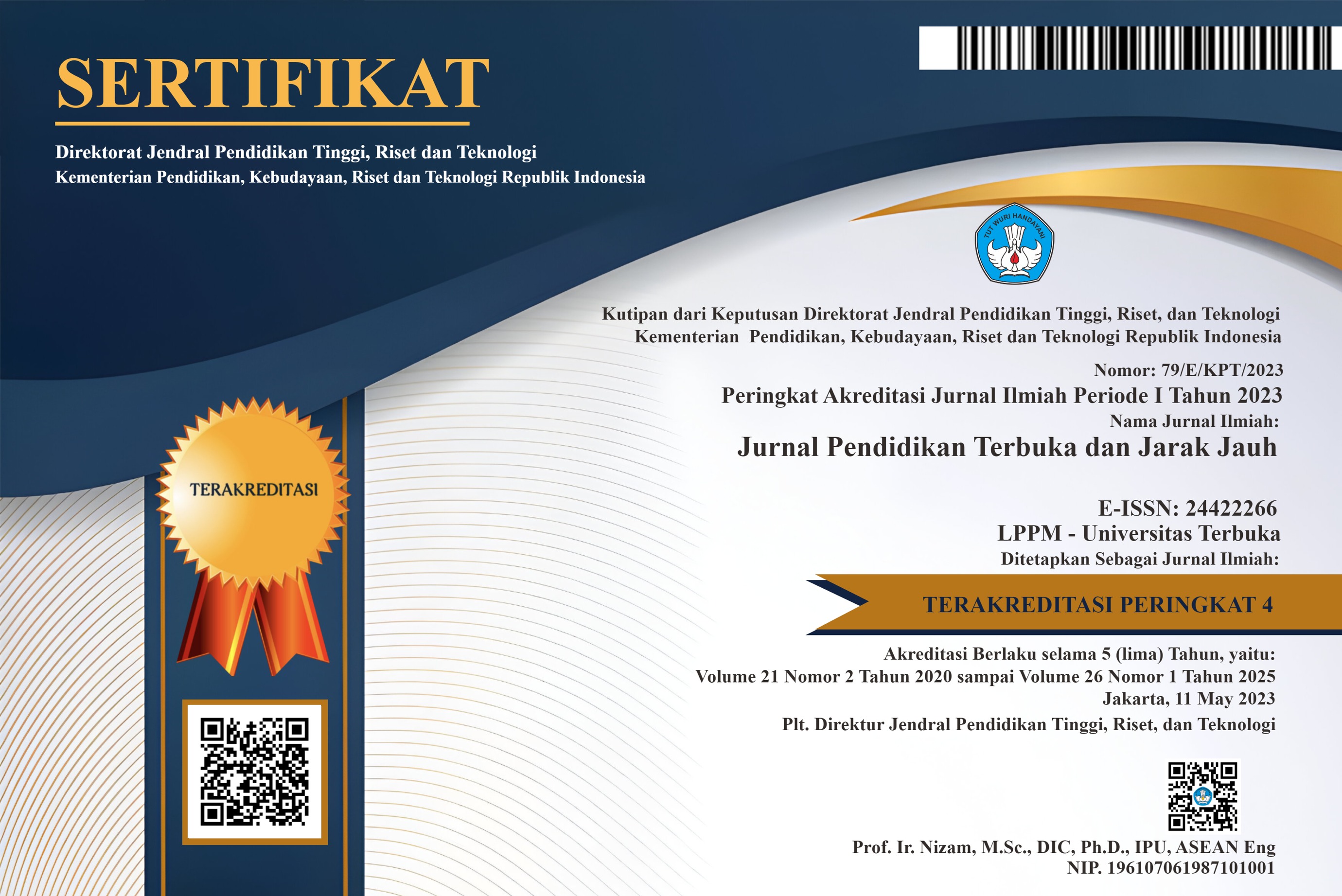ANALISIS BUTIR TES OBJEKTIF UJIAN AKHIR SEMESTER MAHASISWA UNIVERSITAS TERBUKA BERDASARKAN TEORI TES MODERN
Keywords:
classical theory, final exam, item response theory, Model Rasch, rasch model, teori respon butir, teori tes klasik, UAS, Universitas TerbukaAbstract
Universitas Terbuka has been applying a test of final examination for measuring student learning outcomes. Type of final examination that developed is objective test consisting of stem and option. Option of test covering answer key and detractors. A good question should have detractors relatively homogenous, so that it is difficult to guessed by a student. Criteria of good question can be determined by item analysis with using classical test theory and modern test theory. Universitas Terbuka has been doing item analysis based on classical test theory. This theory has the limitations characteristic of the index items were highly dependent on the group of test. Unlike the case with modern test theory (item response theory). Item response theory is based on the ability of individual test. The purpose of this paper is to determine: (1) how the result of the final exam item analysis using item response analysis, (2) how the comparison of the number of valid and invalid between item response analysis and classical test analysis, and (3) how to determine item characteristics of the items and estimate the ability of participants to the test item response using Rasch models. The data used are student answers that took exams on subjects selected sample in 2009.1 and 2009.2. The total sample used by 8 subjects consisting of 16 sets of questions. The study results showed: (1) average difficulty level of the sample items was subject to item response items (Rasch Model) is between 0.618 to 1.417, (2)comparison of the results of the analysis of test items using classical analysis and the Rasch model analysis is very significant, and (3)on the number of examinees who many (over 1,500 people), the number or percentage of items was valid by using item response analysis more than the classical analysis.
Universitas Terbuka menerapkan tes berupa Ujian Akhir Semester untuk mengukur hasil belajar mahasiswa. Tipe soal UAS yang dikembangkan berbentuk tes objektif yang meliputi pernyataan (stem) dan alternatif jawaban (option). Option suatu tes meliputi kunci jawaban dan bukan kunci jawaban (pengecoh). Soal yang baik harus memiliki pengecoh yang relatif homogen, sehingga sulit ditebak oleh mahasiswa. Kriteria soal yang baik dapat diketahui dengan melakukan analisis butir soal baik menggunakan teori tes klasik maupun teori tes modern. Universitas Terbuka melakukan analisis butir soal UAS berdasarkan teori tes klasik. Teori ini memiliki keterbatasan yakni indeks karakteristik butir soal sangat bergantung pada kelompok peserta tes. Pada teori tes modern (teori respon butir), analisis butir soal didasarkan pada kemampuan individu peserta tes bukan berdasarkan kemampuan kelompok peserta tes. Tujuan penulisan artikel ini adalah untuk menentukan: (1) bagaimana hasil analisis butir soal UAS menggunakan teori respon butir, (2) bagaimana perbandingan jumlah soal valid dan tidak valid antara analisis respon butir dengan analisis tes klasik, dan (3) bagaimana menentukan karakteristik soal dan estimasi kemampuan peserta tes dengan analisis respon butir menggunakan model Rasch. Data yang digunakan adalah jawaban mahasiswa yang mengikuti ujian pada 8 mata kuliah sampel terpilih masa ujian 2009.1 dan 2009.2 yang terdiri atas 16 set soal. Hasil penelitian menunjukkan, rata-rata tingkat kesukaran soal mata kuliah sampel dengan teori respon butir (model Rasch) berkisar antara 0,618 sampai dengan 1,417. Perbandingan hasil analisis butir soal model klasik dengan model Rasch sangat signifikan. Pada jumlah peserta ujian yang banyak (lebih dari 1.500 orang), jumlah atau persentase butir soal yang valid dengan menggunakan item respon butir lebih banyak dibanding dengan analisis klasik.
References
Embretson, E. & Reise, S.P. (2000). Item response theory for psychologists. Mahwah: NJ Publications, Lawrence Erlbaum Associates.
Hambleton, R.K. & Swaminathan, H. (1985). Item response theory, principles, and aplications. Boston: Kluwer. Nijhoff Publishing.
Hambleton, R. K., Swaminathan. H., & Rogers, H. J. (1991). Fundamentals of item response Theory. California: Sage Publications, The International Professional Publishers.
Lord, M.L. (1980). Application of item response theory to practical testing problems. New Jersey: Lawrence Erlbaum Associates, Publisher.
Nunnally, J.C. (1981). Psychometric theory, (3rd ed). New Delhi: McGraw-Hill Publishing Company Limited.
Sanaky, H. (1998). Teknik menyusun alat evaluasi belajar mata pelajaran Al-Islam dan bahasa Arab. Makalah disajikan pada Acara Pembinaan Guru Madrasah Muallimat Muhammadiyah, tanggal 26 September 1998. Diambil 20 Februari 2010, dari http://www.docstoc.com/docs/18529273.





